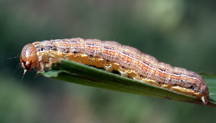Armyworm showing up in specific, at-risk cornfields
May 29, 2014
 |
|
Corn growers need to watch for signs of armyworm in their high-risk fields. The pest can cause devastating damage to cornfields. (Purdue Entomology file photo/John Obermeyer) |
WEST LAFAYETTE, Ind. - While armyworm captures haven't been as high in Indiana as they have in other states to the south, Purdue Extension entomologists say there has been some concentrated armyworm egg-laying in specific, high-risk cornfields.
High-risk fields are those where there is still dense grassy vegetation, such as wheat, grass hay or grass cover crops. Farmers who planted no-till corn into a grass cover crop, especially annual rye, need to scout their fields right away for signs of armyworm feeding.
"Hatched larvae will move from the dying grasses to emerging and emerged corn," said Christian Krupke. "There is nothing else that resembles armyworm feeding at this time of year."
Corn damaged by armyworm feeding has a ragged appearance, with damage extending from the leaf margin toward the midrib. With high enough armyworm populations, most of the plant can be eaten.
Krupke and colleague John Obermeyer said that even if farmers have planted Bt corn hybrids with insect resistance, they need to pay close attention to signs of armyworm.
Both also noted that the pest can cause significant feeding damage before Bt corn can reduce their feeding. Seed-applied insecticides won't control armyworm either.
"In short, there is no in-plant or on-seed solution that will allow you to avoid scouting on this one," Obermeyer said. "Remember, once armyworm larvae reach an inch or more in length, they eat a tremendous amount of foliage in a short period of time and become harder to kill.
"Large areas of seedling corn can be wiped out overnight under heavy infestations."
Krupke said it's important that corn growers remember that armyworm feeds primarily at night, meaning scouting should be done by carefully searching around damaged plants.
The sooner farmers can find armyworm, the better, he said.
"Initially, the damage appears negligible to the plant, but as the armyworms increase in size, so do their appetites," Krupke said. "These small larvae are easy to treat with insecticides. The larger ones are not as easily controlled."
More information about armyworms and management is available through Purdue Extension's Field Crops IPM website at http://extension.entm.purdue.edu/fieldcropsipm/insects/corn-armyworm.php
For armyworm and pest updates throughout the growing season, be sure to follow Purdue Extension's Pest and Crop Newsletter at http://www.extension.entm.purdue.edu/pestcrop/index.html
Writer: Jennifer Stewart, 765-494-6682, jsstewar@purdue.edu
Sources: Christian Krupke, 765-494-4912, ckrupke@purdue.edu
John Obermeyer, 765-494-4563, obe@purdue.edu
Ag Communications: (765) 494-2722;
Keith Robinson, robins89@purdue.edu
Agriculture News Page

